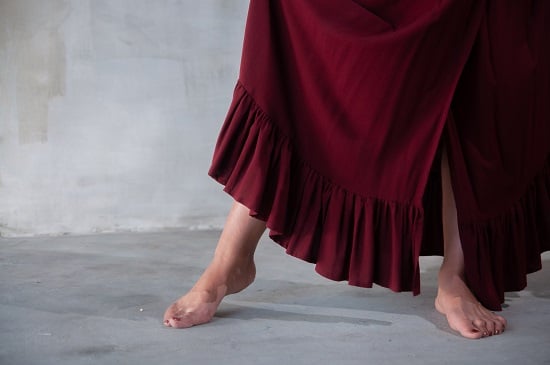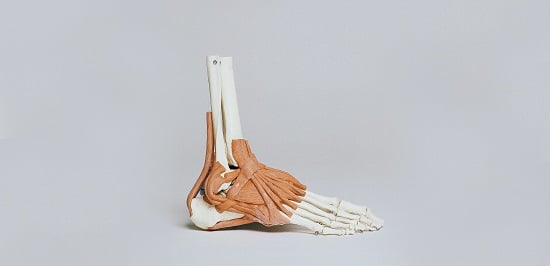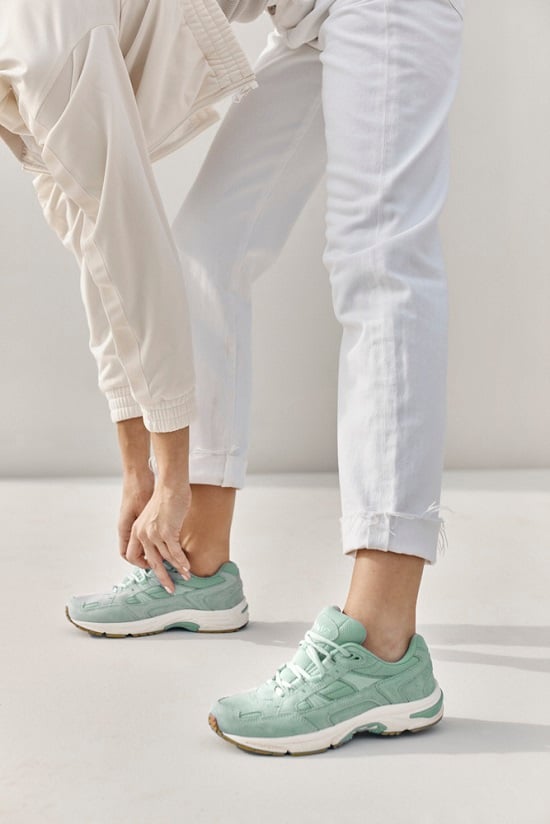Perhaps you’ve been perusing the aisles of your corner grocery store noticing more soreness in your feet than usual. Or, maybe you’re examining your bare feet while basking in the sun, and you’ve noticed that your arches bend far more than your friends’ sitting next to you.
You might be one of the 20% of people with high-arched feet. But don’t worry. There are a few ways you can bring comfort to your unique stride—including gentle exercises, ankle braces, or supportive insoles.
While most people tend to be familiar with the issues that flat feet can cause, high-arched feet are a little less common but can still be just as troublesome. If you’re in need of tips and tricks for how to fix high-arched feet, read on—we’ve got the guide to help soothe your steppers.
High-Arched Feet: Explained
All feet have some natural curvature along the inner sole of the foot, known as the arch. The arch is created by thick connective tissue inside the feet known as ligaments and tendons:
- Ligaments – These connect bones to other bones and help provide the support that allows your body to keep its general structure. In your feet, the largest ligament is known as the plantar fascia, which runs along the bottom of the foot from the heel to the toes.
- Tendons – These connect muscles to bones or to other parts of the body that rely on muscles to move (like eyeballs or noses). While there are many tendons that bridge across the muscles of the feet and calves to bones like the tibia (the calf bone) and the tarsals (the feet bones), the posterior tibial tendon is the main connection for the arch of the foot.
How High Arches Form
So what leads to a high arched foot? Though we all begin with flat feet as babies, the ligaments and tendons begin to develop and strengthen as we age, and we all develop some degree of curvature to the foot.
Those whose connective tissue doesn’t develop as planned can often develop flat feet. Flat feet are one of the most common foot abnormalities, with anywhere between 20% to 30% of the general adult population having some flatness.
Less common than flat feet is their counterpart: high arches. While a high arch, or cavus foot, can sometimes be viewed as a desirable shape for feet, too much of a good thing can lead to foot pain.
Overly high arches can occasionally be caused by chronic skeletal or neurological conditions that can affect the foot by forcing it into a more severe arch, including:
- Muscular dystrophy
- Cerebral palsy
- Spinal bifida
High arches can also be the result of more acute health events, like a stroke or a tumor on the spinal cord. However, most overly arched feet are simply the result of genetics—everyone’s feet (and their arches) are different!
What Kinds of Issues Can High Arches Cause?
Similar to fallen arches, a high arch foot condition can lead to other issues when left untreated. Since all of our weight is supported by our feet when we stand or walk, their structure plays a major part in how the rest of the body feels and moves.
Having high arches often means that the foot lacks the stability that a flatter foot might have. Instead of your weight being evenly distributed across the entire foot, most of the pressure is placed on the parts of the foot that touch the ground: the ball of the foot and your heel.
While you might not feel this unequal pressure directly in your stride, over time this can lead to some issues. The pain and discomfort caused by high arches typically show up in the balls of the feet and along the bottom of the sole, sometimes affecting the entire foot or the ankle.
If you’re sporting sky-high arches, here are a few common conditions to look out for:
- Plantar fasciitis – Remember the plantar fascia, the long ligament running along the bottom of the foot? Because high arches cause you to put more weight on your heel, this ligament can start to suffer from inflammation, causing a burning pain that’s usually focused in the heel but can spread along your entire arch.
- Metatarsalgia – High arches mean that the ball of the foot is also put under stress. This can sometimes result in a condition called metatarsalgia, where the ball of the foot becomes painful and inflamed. This pain usually gets worse when the foot is in motion, and can worsen into numbness, lower body pain, or a limp.
- Toe issues – If you’re placing too much weight in the front of your foot, as high arches can often lead you to do, it can sometimes result in damage to the toes, especially if you’re wearing shoes that aren’t designed for optimal foot health. People with high arches are more at risk of developing hammer toes (where the joints bend inward) or claw toes (where the toes form a “clawed” shape).
- Ankle sprains or injuries – Because high arches are often the result of misshapen bones, you might be a little less steady on your feet, causing frequent tripping or wobbliness and may result in an ankle sprain or injury. You also may be prone to oversupination, or rolling your foot out onto the outer edge excessively when you walk. This can cause ankle instability that heightens your odds of rolling your ankle and potentially spraining or breaking it.
What Can I Do About Overly High Arches?
While high arches can cause some painful problems, the good news is that there’s plenty you can do to alleviate any discomfort and prevent future issues. While you might not be able to change the structure of your high arched foot, there are a ton of tactics to try to make sure your toes (and your ankles, arches, and soles) stay in tip-top shape!
Gentle Movement and Exercise
One of the most important steps you can take toward healthy high arches is finding the right balance between movement and recovery. If you’re suffering from pain caused by complications associated with high-arched feet like plantar fasciitis, it might feel tempting to avoid using your feet whenever possible. However, gentle, high arch-friendly exercise is an important part of building up much-needed strength and stability from the ankles down.
Try incorporating some nourishing, low-impact movement into your routine like:
- Walking
- Swimming
- Cycling
- Pilates
- Yoga
Exercises like these aren’t too hard on your feet, but still give you the chance to build resilience and flexibility. Steer clear of higher-impact activities like running or HIIT classes if your feet are feeling more tender or painful.
As important as exercise is, if you’re experiencing more pain than usual or if you feel activity is making the discomfort worse, you should give yourself time to rest and recover. Proper recovery time can help you avoid making any existing foot inflammation or stress worse and gives you space to recuperate.
Of course, consult your healthcare provider before incorporating exercise into your routine when dealing with foot pain.
Ankle Braces and Support
One of the biggest issues those with high arches face is ankle weakness and instability. This is usually caused by a misshapen bone structure in the foot and is worsened by the tendency to roll the foot outwards as you walk. Ankle weakness can be a serious problem, as it makes you significantly more likely to twist, sprain, or even break your ankle.
To combat this, consider wearing an ankle brace when going for long walks or runs to provide an extra level of rigidity and structure to your ankles.
Don’t want to sport an ankle brace when out and about? Look for shoes with high sides, sturdy heels, and a snug fit for increased stability, like the Vionic Shantelle Ankle Boot in waterproof nubuck or the Walker Classic sneaker, which features a firm, thermoplastic heel counter for extra support.
Orthotics Inserts
Think of orthotic inserts as your high arches’ secret weapon: easy to slip into any pair of shoes in your closet, they can transform uncomfortable, unsupportive footwear into arch-friendly wonders that’ll stay comfortable all day long
If you’re looking for an everyday solution to pain and pressure, try the Vionic Relief Insole, designed by podiatrists for maximum support and comfort, these full-length insoles work in shoes of all shapes and sizes.
Want the stability of orthotics as you’re getting active? High-impact exercise can be tricky if you’re dealing with high arches. Give your feet the help they need by slipping a pair of Active Insoles into your sneakers.
Specially crafted for movement, the Active Insoles are made to absorb shocks and cushion the heels, as well as give you better control of your feet as you’re on the go (perfect for the aching heels and wobbly ankles common with high arches).
Soothe Your High Arches with Vionic
Having higher-than-average arches doesn’t mean that you’re destined for a lifetime of ankle sprains and foot pain. From foot-friendly movement to supportive orthotics, there’s plenty that you can do to stop arch-related discomfort in its tracks—and Vionic is here to help.
Whether it’s shoes created with your foot health (and your style) in mind or insoles that can provide support with every outfit, our footwear makes sure you’re aligned and balanced from head to toe. It’s no wonder so many of our products bear the American Podiatric Medical Association Seal of Acceptance.
Explore our footwear selection to discover shoes designed to keep your feet both looking and feeling great.
Sources:
- Willson, Chloe. “Foot and Ankle Tendons.” Foot Pain Explored. https://www.foot-pain-explored.com/ankle-tendons.html
- Mayer, Catherine. “An Overview of Flat Feet.” VeryWell Health. Updated 14 November, 2021. https://www.verywellhealth.com/flat-feet-causes-and-associated-medical-problems-1337682
- Mayer, Catherine. “High Arched Feet Causes, Diagnosis, and Treatment.” VeryWell Health. Updated 6 Julay, 2022. https://www.verywellhealth.com/high-arched-feet-1337684
- “High Arch Feet.” Cleveland Clinic. https://my.clevelandclinic.org/health/diseases/21719-high-arch-feet







Leave a Reply